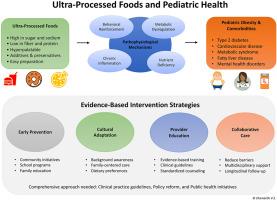The impact of ultra-processed foods on pediatric health
引用次数: 0
Abstract
Introduction
Ultra-processed foods (UPFs) have become increasingly incorporated into pediatric diets, accounting for approximately 67 % of the total energy consumption in United States (US) children. Manufactured through industrial processing and enriched with excess sugars, unhealthy fats, and sodium, while lacking essential nutrients, UPFs present a substantial public health concern. We aimed to conduct a comprehensive review of the impact of UPFs on pediatric health.
Methods
We reviewed the effects of UPF on pediatric health using data from observational studies, systematic reviews, and policy reports. Our review explored the social, environmental, and economic drivers of UPF consumption, associated health consequences, and proposed mitigation strategies. We also examined National Health and Nutrition Examination Survey (NHANES) data, the 2025 US Dietary Guidelines Advisory Committee’s (USDA) report, and the Make America Healthy Again (MAHA) commission findings.
Results
UPF intake has dramatically increased during early childhood, with toddlers and school-aged children obtaining 47 % and 59.4 % of their daily calories, respectively, from UPFs. Higher consumption is linked to pediatric obesity, cardiometabolic risks such as insulin resistance and metabolic dysfunction-associated steatotic liver disease (MASLD), mental health concerns, and gut microbiome disruption. Early-life exposure to UPFs can establish unhealthy dietary patterns that persist into adulthood, raising the risk of chronic disease. Greater UPF consumption is often observed among lower-income families, highlighting a key health disparity.
Conclusion
UPF consumption is a modifiable risk factor for non-communicable diseases in children. Addressing it requires urgent, coordinated action at multiple levels. Strategies include UPF and sugar-sweetened beverage screening during well-child visits, policy restrictions on food marketing, clearer nutrition labeling, healthier school meals, and personalized family-centered dietary counseling. Clinicians need standardized tools and training to counsel families effectively. Policy initiatives should prioritize prevention-focused measures to protect children's health.

超加工食品对儿童健康的影响
超加工食品(upf)已越来越多地纳入儿科饮食,约占美国儿童总能量消耗的67%。upf是通过工业加工制造的,富含过量的糖、不健康的脂肪和钠,同时缺乏必要的营养素,是一个重大的公共卫生问题。我们的目的是对upf对儿科健康的影响进行全面审查。方法我们利用观察性研究、系统评价和政策报告的数据回顾了UPF对儿童健康的影响。我们的综述探讨了UPF消费的社会、环境和经济驱动因素、相关的健康后果,并提出了缓解策略。我们还检查了国家健康和营养检查调查(NHANES)的数据,2025年美国膳食指南咨询委员会(USDA)的报告,以及让美国再次健康(MAHA)委员会的调查结果。结果:在幼儿时期,supf的摄入量急剧增加,幼儿和学龄儿童分别从upf中获得47%和59.4%的每日卡路里。较高的消费量与儿童肥胖、心脏代谢风险(如胰岛素抵抗和代谢功能障碍相关的脂肪变性肝病(MASLD))、心理健康问题和肠道微生物群破坏有关。生命早期接触upf会形成不健康的饮食模式,并持续到成年,增加患慢性病的风险。在低收入家庭中经常观察到更多的UPF消费,突出了一个关键的健康差距。结论upf消费是儿童非传染性疾病可改变的危险因素。解决这一问题需要在多个层面采取紧急、协调的行动。策略包括在健康儿童访问期间进行UPF和含糖饮料筛查,对食品营销进行政策限制,更清晰的营养标签,更健康的学校膳食,以及个性化的以家庭为中心的饮食咨询。临床医生需要标准化的工具和培训来有效地为家庭提供咨询。政策举措应优先考虑以预防为重点的措施,以保护儿童健康。
本文章由计算机程序翻译,如有差异,请以英文原文为准。
求助全文
约1分钟内获得全文
求助全文

 求助内容:
求助内容: 应助结果提醒方式:
应助结果提醒方式:


